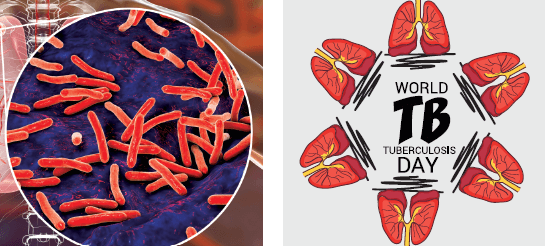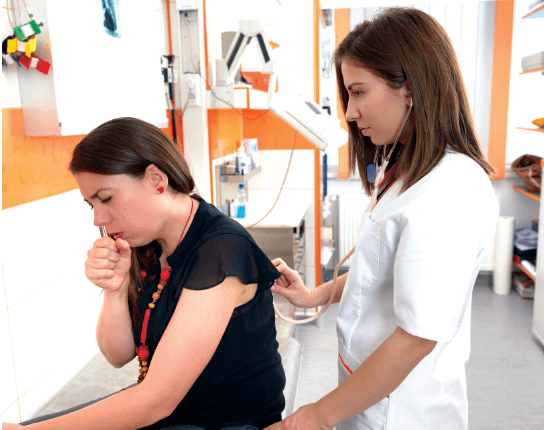Deepti was sixteen years old, writing her board exams when she developed a cough that just wouldn’t go away. After conventional treatment for a month, her doctor advised her to get a chest x-ray which revealed that she had contracted tuberculosis (TB). Despite treatment, Deepti’s condition continued to worsen. She had contracted a strain of TB that was resistant to multiple drugs (MDR or multi-drug resistant) and would need surgery to remove part of her decaying lungs. She was given six months to live. In stark contrast to the lifestyle of Deepti; Salma, a resident of the Dharavi slums nearby, had gone to twelve different doctors searching for a cure for this disease. The strain she had contracted has been dubbed TDR or totally drug resistant and was resistant to 12 different anti-TB drugs. The disease ravaged her for two years, costed money she didn’t have and finally, claimed her life.
India bears the dubious distinction of having the world’s largest number of deaths due to TB; 423,000 people in India succumbed to the disease in 2016, accounting for a third of the entire world’s TB mortality. These TB related deaths that have been identified and reported, the real numbers may be far graver. India has an estimated 1.3 million “missing” TB patients, who may not have been diagnosed or who have not returned for a follow-up post-diagnosis, untreated and potentially spreading TB to others. In addition, WHO estimates that India saw 2.7 million new TB cases in 2016. When compared to the 6.3 million new cases worldwide, Indians accounted for a whopping 25% of all new TB infections.

This is because of the singular and unique ability of the TB bacterium to hide inside the human body in a dormant state without causing the disease or revealing any outward symptoms. Such cases are classified as latent TB infections and can be revealed by diagnostic tests in healthy seemingly uninfected individuals. Studies indicate that close to 40% of the Indian population is positive for latent TB and without treatment 5%-10% of these will develop active TB at some point in their lives. Unfortunately, due to the high burden of TB in India, the detection and treatment of latent TB are not prioritized, resulting in a huge reservoir of dormant and potentially infectious bacteria primed to emerge under favorable conditions.
In 2017, 10 million people were infected with TB and 1.6 million died worldwide, surpassing AIDS as the world’s leading cause of death due to an infectious disease. WHO has designated March 24t has the World TB Day to raise public awareness about TB and its deleterious effects on health, society and the economy. In 2015, it began to implement the ‘End TB Strategy’ which envisions a world free of TB with zero TB related deaths and zero incidences of the disease. In order to do this, WHO aims to support and promote a patient-centric approach to care and prevention, encourage proactive policies and support systems by involving the government and private sector healthcare and finally intensify research and innovation in the field of TB treatment, prevention, and diagnosis. The Government of India has instituted a similar strategy, the Revised National Tuberculosis Control Program (RNTCP). RNTCP involves adopting WHO guidelines of Direct Observation Therapy (DOT) to the Indian scenario and includes direct monitoring and administration of anti-TB drugs to the patient, rapid TB diagnosis and treatment, and increased partnership between public and private healthcare systems. RNTCP’s objective is to eliminate TB by 2025. The plan outlines four directives – Detect, Treat, Prevent and Build and includes a system for free and sensitive diagnostic tests for TB, screening of the high-risk population, free TB drugs for all patients, implementation of a uniform treatment regimen, increased social support and monitoring and treatment of latent TB. Finally, the plan will work towards translation of political commitment to action through strengthening support structures for surveillance, research, and innovation.
Several technological innovations have facilitated easier and improved patient monitoring, such as 99DOTS which is a low-cost solution for improving patient compliance during TB treatment. Patients using 99DOTS receive medication in specially packaged blister packs. Dispensation of a dose reveals a hidden and unique phone number that the patients can call for free and confirm that the medication has been taken. In this way, remote monitoring of patient compliance has been made possible. Several digital adherence technologies have also been developed as an electronic way to monitor medication and provide reminders. These include digital pill boxes (evriMED, Wisepill, etc.) that are given to patients with their medication inside. The digital boxes provide visual cues such as colored LED lights which turn on and remind the patient of the dose and the medicine that is due. These boxes can also record medication events in real time by logging the opening of the box for each dose, allowing for real-time monitoring of patient compliance. Pilot studies are also underway in the US for ingestible sensors that are embedded inside each pill, which transmits information that the pill was consumed upon activation inside the patient’s stomach. However, the cost of such technology is yet to be estimated and given WHO and Govt. of India goals to reduce the economic burden of TB, cost-effective ingestible sensors may remain only a distant possibility.
Risk Factors for TB
Being primarily a respiratory disease, TB is disseminated by airborne infection as the bacteria is exhaled from an infected individual and inhaled by another. This often happens in poorly ventilated and over-crowded settings typically seen in cramped housing where the disease can spread like wildfire. Indeed, earlier TB was thought to be hereditary as it used to wipe out entire households. Weakening of the body’s immune system due to age, substance abuse, air pollution, diabetes, HIV infection, and malnutrition, among others, play a major role in increasing susceptibility to TB. Its spread is seen across the socio-economic strata. As Dr. Zarir Udwadia, one of the world’s leading pulmonologists puts it, “TB does not distinguish between the chauffeur driving the Mercedes and the CEO sitting at the back!”
Detection and Diagnosis of TB
One of the main challenges in the fight against TB is the very first step of diagnosis. Millions of TB cases go undetected and unrecorded all over the world due to the shortcomings of technology. Conventional TB diagnosis is performed by sputum smear microscopy, wherein the sputum of the patient is examined under a microscope for TB bacilli. However, this approach is only 36-43% sensitive which means that many cases of TB infection are missed by this method.
Sputum smear microscopy also suffers from false positives, as some non-TB bacilli may also pick up the TB specific stain. Therefore, a positive sputum smear needs to be confirmed by culturing the bacilli obtained from the sputum in the lab, which can then be tested to confirm TB. Unfortunately, growing patient strains and analyzing them requires resources and technical expertise that are not available in most of the high prevalence countries. In addition, growth-based confirmation of TB positivity takes a minimum of 21 days since the growth rate of the bacilli is extremely slow.
A third technique, which involves the detection of TB DNA using polymerase chain reaction (PCR) and named Xpert MTB/RIF promises results of sample positivity within 2 hours and is currently the gold standard in PCR based TB diagnosis. However, this system suffers from high costs per assay and the requirement for infrastructure and constant electricity, which are not available in many cases.

Treatment for TB
Active TB infections are treated with a standard 6-9 months treatment regimen involving four antibiotics: rifampin, isoniazid, ethambutol, and pyrazinamide for varying durations. This treatment duration is one of the longest for bacterial infectious disease, second only to the treatment of leprosy. Side effects like itching, rashes, fever, nausea, diarrhea and reddish/orange discoloration of body fluids including urine, tears, and saliva is another cause of worry which takes a physical, emotional and mental toll on the patient.
Since most infected individuals begin to feel better after a few weeks of treatment and the length and side-effects of the drug treatment are arduous, many patients stop the treatment prematurely or skip doses. Rampant patient non-compliance when it comes to the completion of anti-TB therapy is one of the main factors for the emergence of a more severe form of the disease, one which is resistant to common drugs! This is a big reason for TB reactivation and the continued prevalence of this disease even though it is completely curable in most cases.
Drug resistance in TB has been known since the first antibiotics to treat this disease were put into place. An increasingly larger repertoire of drug-resistant strains necessitated and increasingly larger arsenal of drugs to treat the disease. As of today, TB strains resistant to one of the first line of four antibiotics are called resistant strains. Strains resistant to two first-line antibiotics are called multi-drug resistant strains of TB or MDR-TB. These are treated with a second line of antibiotics, consisting of fluoroquinolones (levofloxacin, moxifloxacin, and gatifloxacin) or injectable drugs such as amikacin, kanamycin, and streptomycin. More recently, the third category of strains labeled Extensively drug-resistant- or XDR-TB has been described with resistance to a fluoroquinolone and at least one of three injectable drugs. A total of 12 drugs are approved today, each of which individually and in combination is used to treat these three categories of TB, MDR-TB, and XDR-TB. However, a little characterized fourth type of strain dubbed totally drug-resistant- or TDR-TB has been reported in India, Italy, Iran, and South Africa. These strains are completely resistant to all known anti-TB medication and given the airborne and infectious nature of the disease, are ticking time bombs of catastrophe.
Newer Strategies in TB Healthcare
The emergence of drug resistance, the persistently high rate of TB incidence and TB mortality and the challenges associated with patient non-compliance demand improved methods to detect TB with high accuracy, newer drugs to treat resistant forms of TB and increased awareness of the disease.
Bedaquiline and delamanid are two new drugs for TB that have shown promising results in clinical trials after nearly 40 years of failed attempts. These two drugs have received approval for use in the treatment of MDR- and XDR-TB. Additionally, a new drug combination involving bedaquiline, pretomanid and linezolid is reported to have successfully treated XDR-TB in six months with a lower mortality rate than current treatments. However, these new treatment regimens are yet to enter mainstream clinical practice, with further and larger clinical trials needed to make an accurate cost-benefit analysis of these strategies.
Looking to the Future
Although the current situation of TB in India and worldwide looks bleak, the global TB incidence is falling at a rate of 2% per year. According to WHO, this rate needs to increase to 5% to achieve the WHO Global Plan to End TB milestones of reaching 90% of all people with TB through national TB programmes, reaching at least 90% of vulnerable high-risk population through affordable treatment and achieve at least 90% success in the treatment of all people diagnosed with TB. Achieving both WHO and RNTCP milestones will require a concerted effort by policymakers, healthcare providers, TB researchers, patients, and the general public. What we need today is increased public spending on healthcare to make TB therapy affordable and accessible, improvement of research funding and infrastructure and stronger public awareness campaigns to disseminate the reality and requirements of ending TB.
Over just the past two centuries, TB is estimated to have killed 1 billion people, which is more than the number of people killed due to AIDS, cholera, influenza, plague, and smallpox combined! It is time we take the initiative and responsibility to help the millions that are suffering from this deadly disease.
About the Author
Vignesh Narayan is a scientist and science writer at the Indian Institute of Science who currently studies the molecular biology of the TB pathogen Mycobacterium tuberculosis in an attempt to understand how the bacterium senses and responds to its environment and develop new drugs and drug targets to combat the disease.

